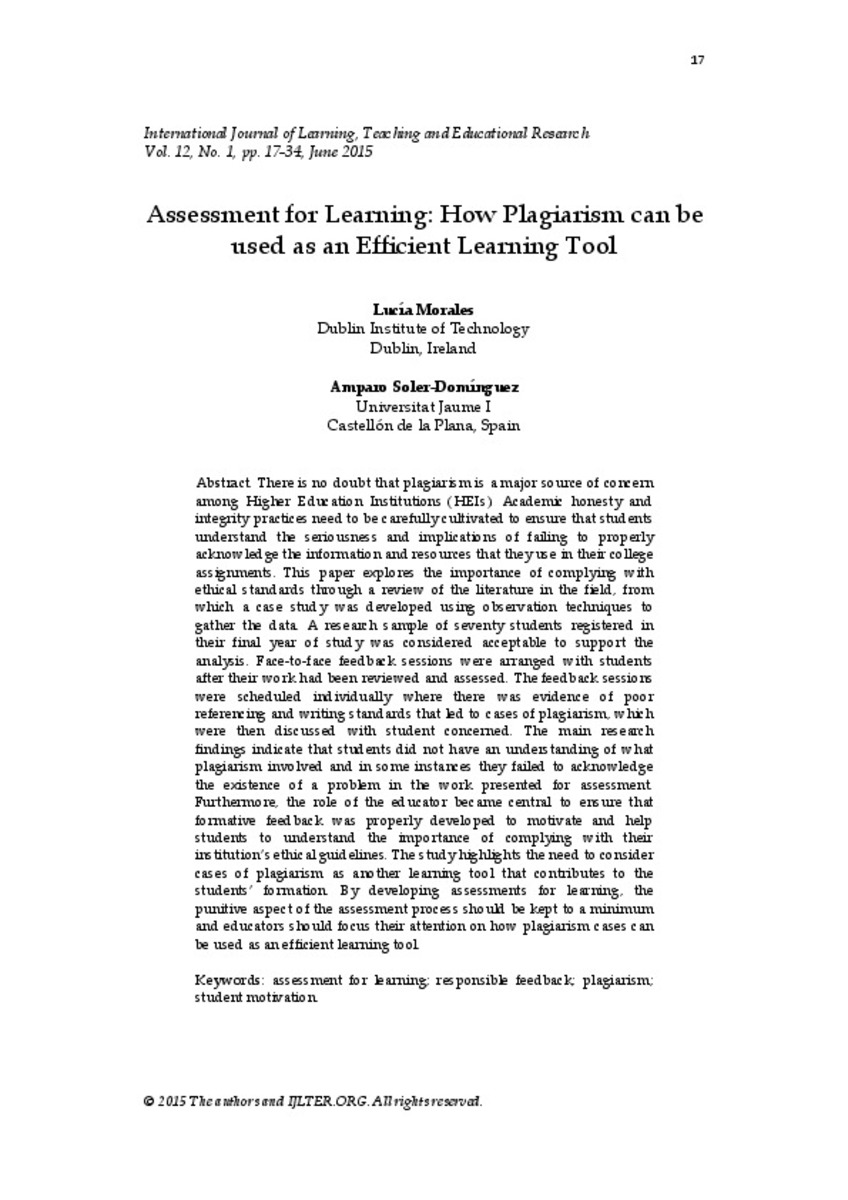Mostrar el registro sencillo del ítem
Assessment for Learning: How Plagiarism could be used as an Efficient Learning Tool
| dc.contributor.author | Morales, Lucia | |
| dc.contributor.author | Soler-Dominguez, Amparo | |
| dc.date.accessioned | 2016-10-11T14:17:18Z | |
| dc.date.available | 2016-10-11T14:17:18Z | |
| dc.date.issued | 2015 | |
| dc.identifier.citation | MORALES, Lucia; DOMINGUEZ, Amparo Soler. Assessment for Learning: How Plagiarism could be used as an Efficient Learning Tool. International Journal of Learning, Teaching and Educational Research, 2015, vol. 12, no 1. | ca_CA |
| dc.identifier.issn | 1694-2493 | |
| dc.identifier.issn | 1694-2116 | |
| dc.identifier.uri | http://hdl.handle.net/10234/163573 | |
| dc.description.abstract | Instructors should consider the role of responsible feedback as one of the main priorities of their teaching and learning strategies. It is well known that feedback is the bridge between students and instructors, as students’ work is reviewed and put into an appropriate learning context. In this context, we argue that detecting plagiarism should be an additional vehicle to allow students achieve settled academic standards. Plagiarism detection tools should be used to encourage students to follow best practices, and at the same time inspire and guide students to work harder. In this regard, quality feedback plays a crucial role in identifying areas of weaknesses in standards of writing, which should be considered carefully by instructors when guiding their students to comply with academic rules and standards. We must not forget that students are learners that need tutoring, mentoring, objective and clear guidelines that keep them focused and motivated, and this also applies to adhering to academic integrity. Accordingly, we argue that instructors’ feedback should also address academic integrity in an efficient and constructive manner. Plagiarism has very negative connotations in academia, and must be monitored. However, in this context, the following questions remain pertinent: What kind of action is required to prevent plagiarism? How can instructors use plagiarism as another tool to motivate and guide their students? What way can plagiarism be used for constructive learning and not as a way to punish students? We believe that the answers lie in responsible feedback. We explore the use of plagiarism as a constructive tool that can make a difference in the learning experience. We aim to offer an initial view of how instructors could shift from using plagiarism as a source of punishing students to a more constructive and positive end. | ca_CA |
| dc.format.extent | 18 p. | ca_CA |
| dc.format.mimetype | application/pdf | ca_CA |
| dc.language.iso | eng | ca_CA |
| dc.relation.isPartOf | International Journal of Learning, Teaching and Educational Research, 2015, vol. 12, no 1. | ca_CA |
| dc.rights | © 2015 The authors and IJLTER.ORG. All rights reserved. | * |
| dc.rights.uri | http://creativecommons.org/licenses/by-nc-sa/4.0/ | * |
| dc.subject | Assessment for Learning | ca_CA |
| dc.subject | Responsible Feedback | ca_CA |
| dc.subject | Plagiarism | ca_CA |
| dc.subject | Student Motivation | ca_CA |
| dc.title | Assessment for Learning: How Plagiarism could be used as an Efficient Learning Tool | ca_CA |
| dc.type | info:eu-repo/semantics/article | ca_CA |
| dc.rights.accessRights | info:eu-repo/semantics/openAccess | ca_CA |
| dc.relation.publisherVersion | http://www.ijlter.org/index.php/ijlter/article/view/346 | ca_CA |
| dc.edition | PDF de la editorial | ca_CA |
| dc.type.version | info:eu-repo/semantics/publishedVersion |
Ficheros en el ítem
Este ítem aparece en la(s) siguiente(s) colección(ones)
-
COFIN_Articles [213]








